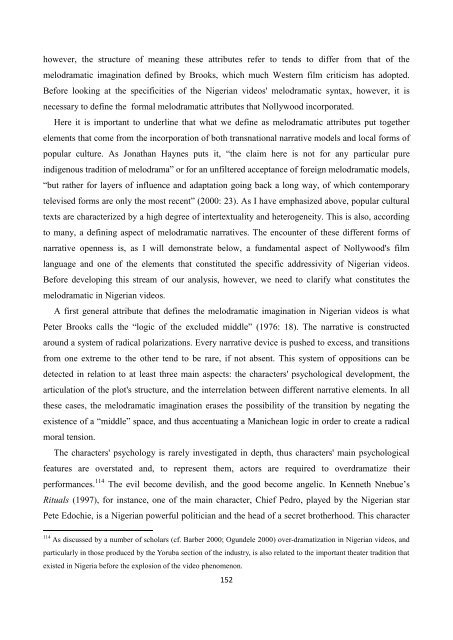Create successful ePaper yourself
Turn your PDF publications into a flip-book with our unique Google optimized e-Paper software.
however, the structure of meaning these attributes refer to tends to differ from that of themelodramatic imagination defined by Brooks, which much Western film criticism has adopted.Before looking at the specificities of the Nigerian videos' melodramatic syntax, however, it isnecessary to define the formal melodramatic attributes that Nollywood incorporated.Here it is important to underline that what we define as melodramatic attributes put togetherelements that come from the incorporation of both transnational narrative models and local forms ofpopular culture. As Jonathan Haynes puts it, “the claim here is not for any particular pureindigenous tradition of melodrama” or for an unfiltered acceptance of foreign melodramatic models,“but rather for layers of influence and adaptation going back a long way, of which contemporarytelevised forms are only the most recent” (2000: 23). As I have emphasized above, popular culturaltexts are characterized by a high degree of intertextuality and heterogeneity. This is also, accordingto many, a defining aspect of melodramatic narratives. The encounter of these different forms ofnarrative openness is, as I will demonstrate below, a fundamental aspect of Nollywood's filmlanguage and one of the elements that constituted the specific addressivity of Nigerian videos.Before developing this stream of our analysis, however, we need to clarify what constitutes themelodramatic in Nigerian videos.A first general attribute that defines the melodramatic imagination in Nigerian videos is whatPeter Brooks calls the “logic of the excluded middle” (1976: 18). The narrative is constructedaround a system of radical polarizations. Every narrative device is pushed to excess, and transitionsfrom one extreme to the other tend to be rare, if not absent. This system of oppositions can bedetected in relation to at least three main aspects: the characters' psychological development, thearticulation of the plot's structure, and the interrelation between different narrative elements. In allthese cases, the melodramatic imagination erases the possibility of the transition by negating theexistence of a “middle” space, and thus accentuating a Manichean logic in order to create a radicalmoral tension.The characters' psychology is rarely investigated in depth, thus characters' main psychologicalfeatures are overstated and, to represent them, actors are required to overdramatize theirperformances. 114 The evil become devilish, and the good become angelic. In Kenneth Nnebue’sRituals (1997), for instance, one of the main character, Chief Pedro, played by the Nigerian starPete Edochie, is a Nigerian powerful politician and the head of a secret brotherhood. This character114 As discussed by a number of scholars (cf. Barber 2000; Ogundele 2000) over-dramatization in Nigerian videos, andparticularly in those produced by the Yoruba section of the industry, is also related to the important theater tradition thatexisted in Nigeria before the explosion of the video phenomenon.152
















